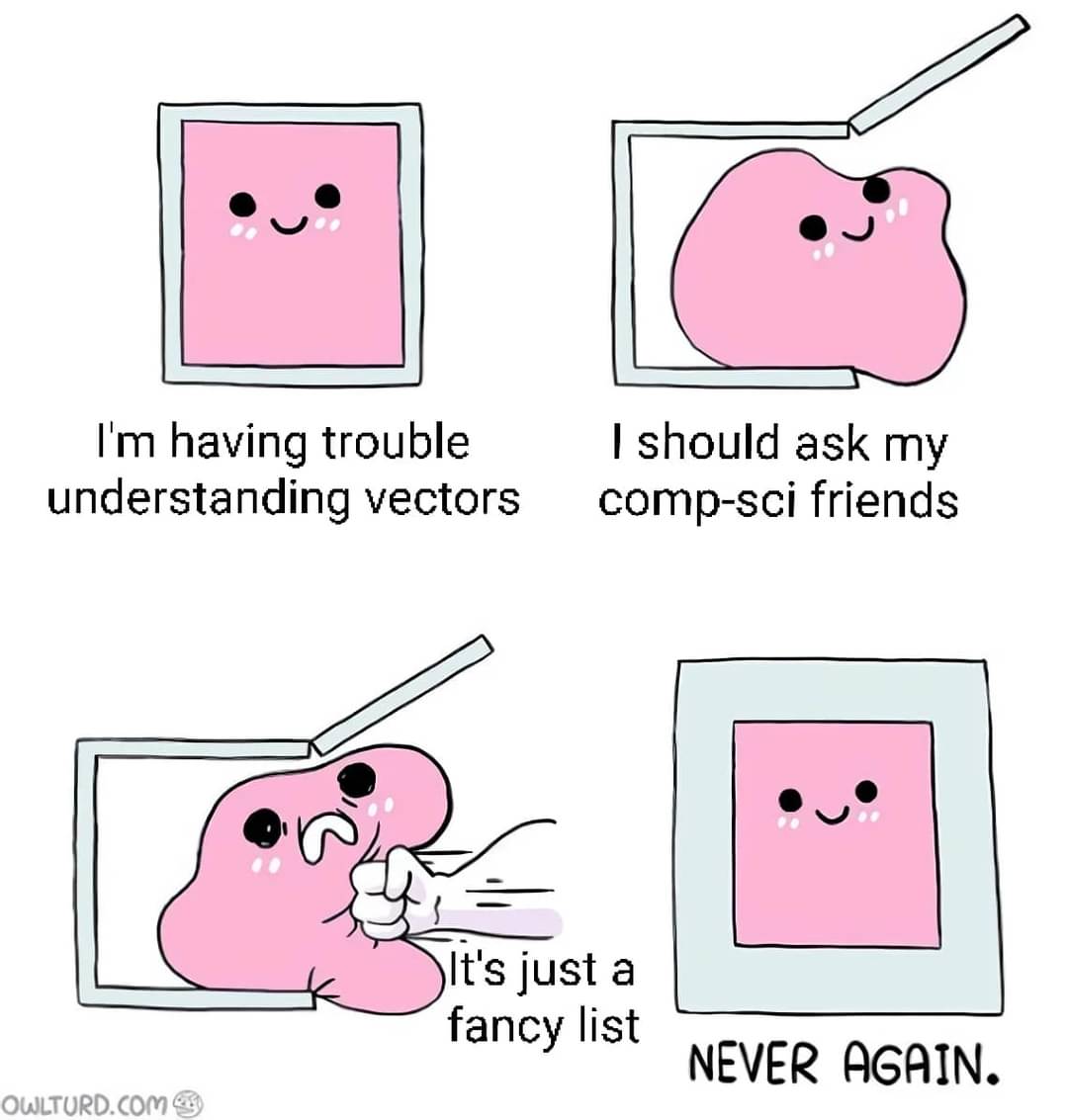This might hit harder if it weren't for the fact that words very can have multiple senses
Science Memes
Welcome to c/science_memes @ Mander.xyz!
A place for majestic STEMLORD peacocking, as well as memes about the realities of working in a lab.

Rules
- Don't throw mud. Behave like an intellectual and remember the human.
- Keep it rooted (on topic).
- No spam.
- Infographics welcome, get schooled.
This is a science community. We use the Dawkins definition of meme.
Research Committee
Other Mander Communities
Science and Research
Biology and Life Sciences
- [email protected]
- [email protected]
- [email protected]
- [email protected]
- [email protected]
- [email protected]
- [email protected]
- [email protected]
- [email protected]
- [email protected]
- [email protected]
- [email protected]
- [email protected]
- [email protected]
- [email protected]
- [email protected]
- [email protected]
- [email protected]
- [email protected]
- [email protected]
- [email protected]
- [email protected]
- [email protected]
- [email protected]
- !reptiles and [email protected]
Physical Sciences
- [email protected]
- [email protected]
- [email protected]
- [email protected]
- [email protected]
- [email protected]
- [email protected]
- [email protected]
- [email protected]
Humanities and Social Sciences
Practical and Applied Sciences
- !exercise-and [email protected]
- [email protected]
- !self [email protected]
- [email protected]
- [email protected]
- [email protected]
Memes
Miscellaneous
As a mathematician this genuinely hurts. Lol.
It's an array.
First time I heard of vectors in comp-sci was in C++. The naming still doesn't make sense to me.
Ooh, do tensors next!
You should ask your biologist friend and your physicist friend and your compsci friend to debate about what vectors are. Singularities, too.
Tensors are easy!
It’s just a fancy list of fancy lists! :D
Singularities, too.
/dev/null

Well mathematically isn't it an n by 1 matrix.
Not always. Any m by n matrix is also a vector. Polynomials are vectors. As are continuous functions.
A vector is an element of a vector space over a field. These are sets which have a few operations, vector addition and scalar multiplication, and obey some well known rules, such as the existence of a zero vector (identity for vector addition), associativity and commutativity of vector addition, distributivity of scalar multiplication over vector sums, that sort of thing!
These basic properties give rise to more elaborate concepts such as linear independence, spanning sets, and the idea of a basis, though not all vector spaces have a finite basis.
How are polynomials vectors how does that work?
Say u have polynomial f(x)= a + bx + cx^2 + dx^3
How is that represented as a vector? Or is it just one of those maths well technically things? Cos as far as I'm aware √g = π = e = 3.
Are differential eqs also vectors?
Your polynomial, f(x) = a + bx +cx^2 + dx^3, is an element of the vector space P3(R), the polynomial vector space of degree at most 3 over the reals. This space is isomorphic to R^4 and it has a standard basis: {1, x, x^2, x^3}. Then you can see that any such f(x) may be written as a linear combination of the basis vectors with real valued scalars.
As an exercise, you can check that P3(R) satisfies some of the properties of vector spaces yourself (existence of zero vector, associativity and commutativity of vector addition, distributivity of scalar multiplication over vector sums).
What happens to elements with powers of x above 3? Say we multiply the example vector above with itself. We would end up with a component d^2^x^6^, witch is not part of the P3R vector space, right?
Do we need a special multiplication rule to handle powers of x above 3? I've worked with quaternions before, which has " special" multiplication rules by defining i j and k.
Multiplication of two vectors is not an operation defined on vector spaces. If you want that, you’re looking at either a structure known as an inner product space or an algebra over a field.
Note that the usual notion of polynomial multiplication doesn’t apply to polynomial vector spaces, nor does it agree with the definition of an inner product nor the bilinear product of an algebra.
That's only if you're working with the perspective of it being a polynomial. When you're considering the polynomial as a vector however, that operation simply doesn't exist
Wouldn't N by M be a tensor? Magnitude and direction only need one entry per DOF.
Every vector is a tensor. Matrices are vectors because m by n matrices form vector spaces. Magnitude and direction have nothing to do with the definition of vectors which are just elements of vector spaces.
All vectors are tensors but not vice versa. And every page/definition of vector I've seen references magnitude and direction, even the vector space page you linked.
It looks like "vector" commonly refers to geometric vectors which is what most folks in this thread are discussing.
Would N by M vectors be imaginary, where each DOF has real and imaginary components?
Continuous functions on [0,1] are vectors. Magnitude and direction are meaningless in that vector space, usually called C[0,1]. Magnitude and direction are not fundamental properties of vectors.
n by m matrices (and the vector spaces to which they belong) are perhaps best thought of similarly to functions and function spaces. Not as geometric objects, but as linear transformations (which they are).
